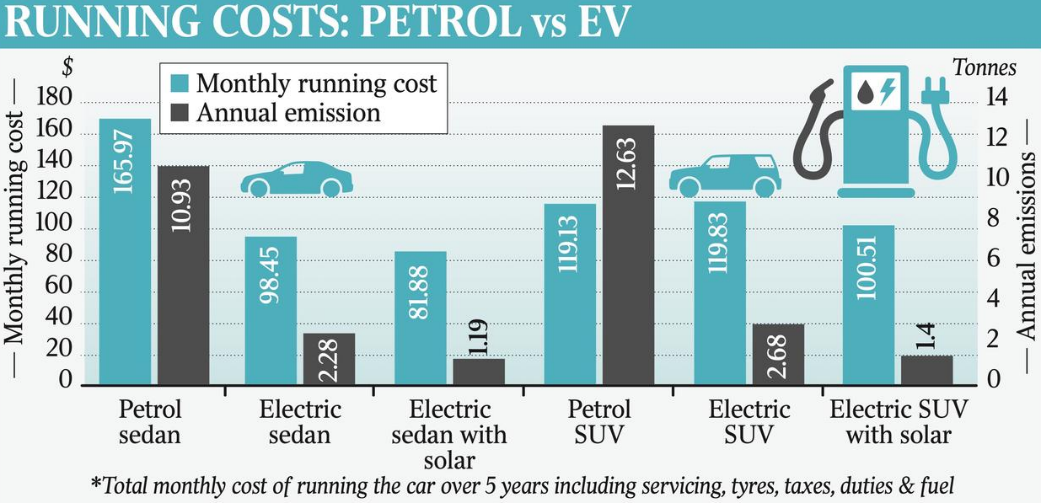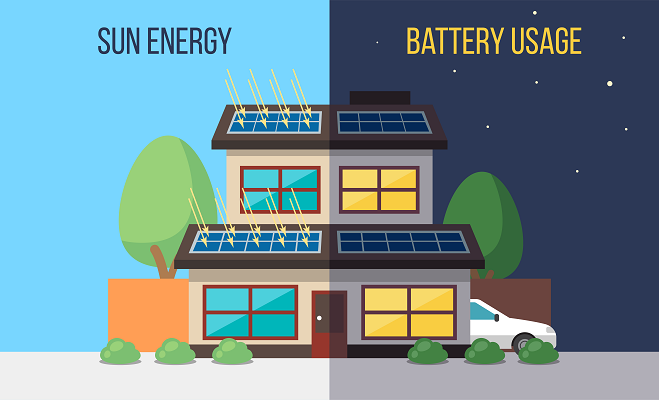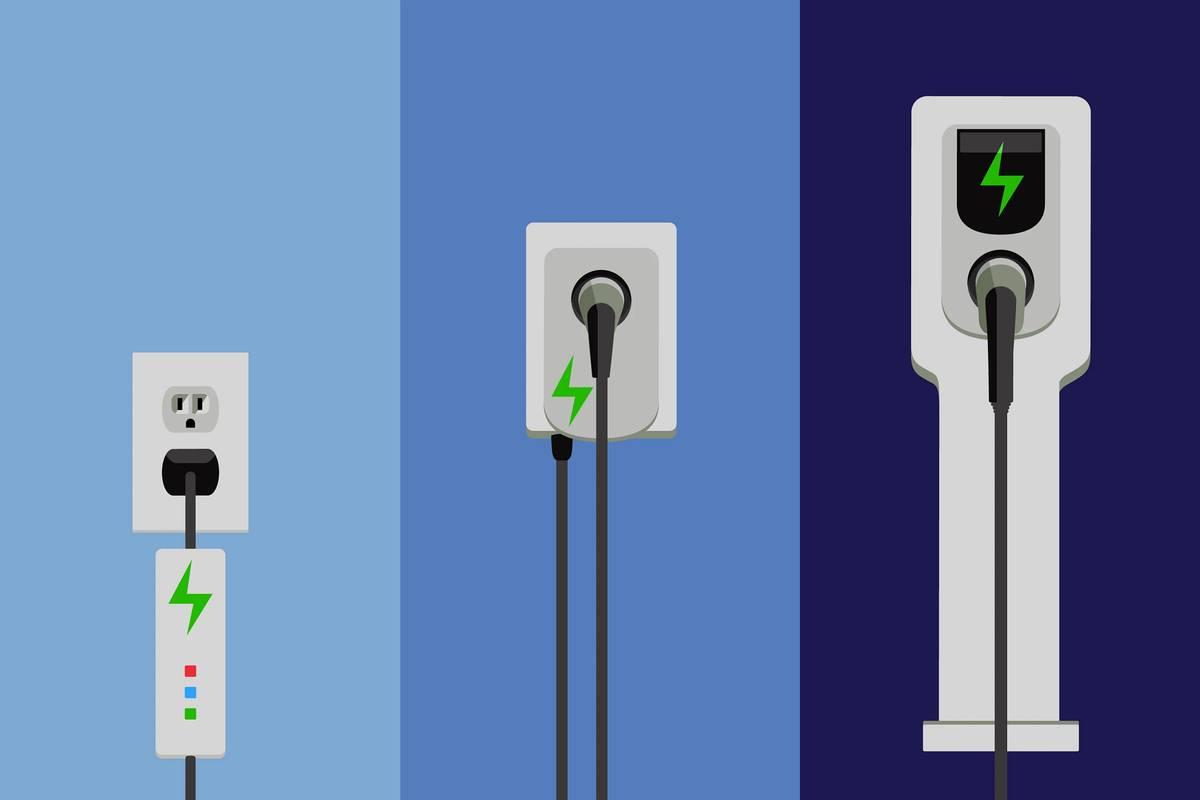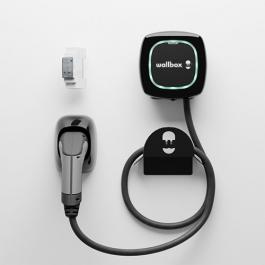Unlike petrol-engine cars, EV driving costs and GHG emissions for EVs can be brought down by using surplus or stored solar energy to power the EV directly. So if you have a solar or home battery system (or thinking of getting one), you’re in luck!

Here we explain the benefits of charging an EV with a solar array, estimate the number of modules required to cover your driving habits and introduce you to the best EV chargers that feature Smart Solar charging.
What Do I Need to Charge My EV With Solar Power?

Many Australian homeowners already own a battery-based solar photovoltaic (PV) system (i.e. a solar or battery system) to partially or fully cover their daily energy needs.
Some households have a solar array bigger than they need and end up injecting power into the grid, which makes them lose money in the process considering the feed-in tariffs of 5.0 up to 7.1 cents per kWh. Feed-in tariffs are a subsidy mechanism implemented for renewable energy sources all across the world, which compensates energy producers (i.e. your excess solar) for the electricity that is injected back to the grid. Currently in Australia, feed-in tariff values are much lower than standard electricity rates, meaning that you buy the energy back from your power company more than you sold it for.
Homeowners who have only a grid-tied PV system (no batteries) need to self-consume as much solar power as they can during the day to maximise the value for their solar (ideally charging their EV during the day). However, many will still need to export solar power back to the grid as solar generation does not always match their consumption patterns (if you take your EV to work all day, you will return home at night, meaning all or most of solar power generation would be exported, losing value).
But, if the homeowner has a solar battery-based system, all the extra solar power generation that is not self-consumed, can be stored inside the battery system for later use (including charging the EV). This maximises the value for the solar because instead of sending it back to the grid at 5-7.1 cents/kWh, and then charging your EV at night at 21 cents/kWh (Victoria average), you are actually storing the solar energy for later use at night. In other words, under this case example, adding a battery would be saving you around 15 cents per kWh used for charging your EV. No matter which one is your situation, powering an EV with a solar charging system will always be good for you.
The Levelised Cost of Energy of Energy (LCOE) (average revenue per MWh required to recover the costs of building and operating a generation plant over its lifetime) for solar energy was estimated at AUD50 – $55 per MWh (5.0 –5.5 cents per kWh) in the last GenCost report by CSIRO. Considering that the average unit of electricity costs around 27 cents per kWh, charging an EV with solar power can potentially save you more than 70% on electricity expenses to charge your electric car.
To make home solar EV charging even easier for you, some EV chargers include a solar integration capability that completely integrates your PV system into the charging process. This allows you to choose how much and what type of energy to use when charging your EV. To use this function you need to hook up the charger to the switchboard to use surplus solar power directly or to the battery storage system to charge the EV with stored solar energy. This is always completed by a qualified electrician.
What Is More Convenient, Charging With Stored Solar Energy or Surplus Solar Energy?

You can charge an EV with solar surplus power generated by your rooftop PV system or with solar energy stored in your batteries. The decision will depend entirely on your driving habits.
If you work during the day (and you’re not at home), there is not much of a choice. In this case, you are forced to charge your EV battery during the afternoon or night. In this scenario, you cannot charge with surplus solar energy since there will not be solar power generation by the time you connect your EV. To make use of the generated solar energy, you will need to make use of a home battery.
EV drivers working night shifts, remote working, or that simply stay at home during the day (a retiree for instance), can charge their EV with surplus energy generated by the rooftop PV system during the day. This is the safest bet since they can charge the EV at a cheaper cost without needing to use a home battery. This allows taking full advantage of every kilowatt-hour generated by their solar array.
What Is the Best EV Charging Level for You?

To charge your electric car with home solar, you need the right charger. A level 1 EV charger features a maximum power rate of 2.4 kW, so this charger could cover your 6.06kWh daily needs. However, it is not designed to function as a solar electric vehicle charging system and on top of that it could leave you stranded on the road the next day after discharging your EV more than usual during a long trip.
The best option is to buy a Level 2 EV solar electric car charger (these are the common home chargers). You could go for a single-phase EV charger that goes up to 7.2kW or a three-phase charger that features up to 22kW. Some of the best options featuring solar integration are the Wallbox Pulsar Plus and the Zappi EV charger. If you need help selecting a charger, feel free to reach out to us!

Wallbox Pulsar Plus
The Wallbox Pulsar Plus is an EV charger featuring smart solar as a built-in option, all calculations are done via an external meter. You can use the Full Green mode to completely charge with solar power or the ECO mode to charge with mixed energy sources, partially reducing the energy consumed from the grid. This solar electric car charger comes with a single-phase 7.2kW and a three-phase 22kW option.
Zappi
With the Zappi EV charger, you can demand power from the grid with the Fast mode or use the different ECO charging modes to partially reduce or eliminate grid usage and power your EV entirely with solar power. This solar electric car charger comes in a single-phase (7.2kW) or three-phase (22kW) variation and requires installing CT clamps to use solar charging. This is always done by a qualified electrician.
Read More- A Guide to EV Charging Connector Types
revcharge is an end-to-end EV charging service provider. We take the stress and guesswork out of not only finding an EV charger that meets your needs, but that too of organising a trained technician to install and activate your system. Every EV charger on offer has been carefully evaluated for its performance and features by our specialised team.
Our goal is to save you time and money, while ensuring a quality install that will last you for years to come. All you have to do is answer some quick questions about your home and electric car and send us photos of your switchboard and preferred charger location. We’ll take care of the rest!
Learn more here and get an obligation-free quote today!